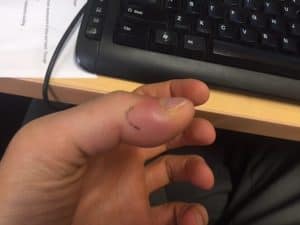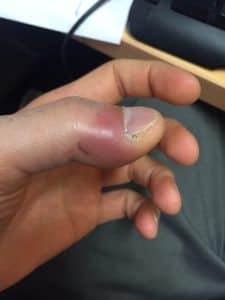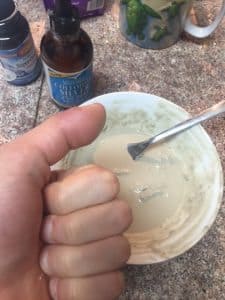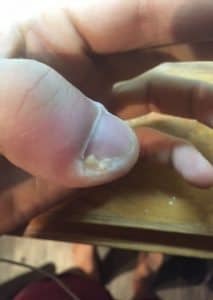Rather than potentially putting myself in harms way legally by bragging about what bentonite clay can do for you, I’m just going to share a story of what bentonite clay did for me, with photographic evidence. Our government can’t stop me from telling a story, right?
Note: Bentonite clay should not be used by kids or mothers who are nursing or pregnant.
The story…
About four years ago, I had an infection in my finger that started in my nail bed. Having not taken a prescription or over-the-counter drug in years, I considered going to a doctor a last resort. I figured I’d be put on a dose of antibiotics and he’d want to numb me with a needle and slice open my thumb.
I traced in pen the swelling to see if the infection was spreading and unfortunately, each day the pain grew worse and my thumb got angrier. The slightest touch on the infected area, or even grabbing the shower handle would produce intense pain.
I tried every oral herbal antibiotic you could imagine that would kill bacteria to no avail, the thumb just got more red and swollen. I tried soaking the thumb in food grade hydrogen peroxide (this is often discouraged by western medical doctors because finger tissue is thought to be too sensitive). While soaking, I noticed there were no bubbles or fizzing taking place, meaning the peroxide was not reaching the infection because my thumb had sealed it off.
I believed if I could just deliver the hydrogen peroxide to the inside of my
thumb, any infection would quickly be cleaned out; but after minutes of soaking, I wasn’t seeing any bubbles. I knew a doctor would cut open my thumb to relieve the pressure and release the infection, so I took matters into my hands (I regret this). With a sterilized needle, I attempted to poke a hole in my thumb. Not smart. I was desperate. It hurt. A lot. I was able to get the needle into my thumb and heard a “pop” but there was still no fizzing action in the peroxide. In other words, I just jabbed a needle into my incredibly painful thumb for no reason.
In a last ditch effort to save my thumb from a doctor’s knife, I made a poultice with bentonite clay and gauze. Honestly, I didn’t know what I was doing. I’d not read an article like this on the internet first. This was an experiment. I was familiar with bentonite clay’s reputation as an internal supplement, but had to do a little internet research to remind myself this was worth a shot. Before going to bed, I packed the wet clay all over my thumb, wrapped it in gauze, and put my head on the pillow with an aching thumb. What happened next was truly incredible.
I woke up aroun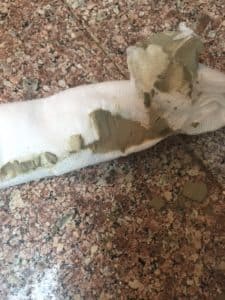
Note: The puss came from the cuticle bed on my thumb’s right corner and not from the hole that was made, and quickly closed up earlier by the needle. It’s mind boggling that a soft powder mixed with water was more effective at creating an opening in my finger than a sharp needle.
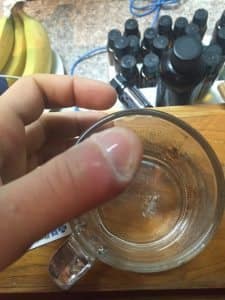
Historical accounts of medicinal clay use began with Aristotle Pliny the Elder (23-79 AD) and Aristotle (384-322 BC).
Other uses of bentonite clay
Bentonite clay is used as a face mask to help with acne and smooth skin and is used in baths to draw toxins out of the body (much like the infection was drawn from my thumb). It is also used internally for detoxification purposes, especially for removing heavy metals. Many studies have shown bentonite clay has antibacterial properties. Bentonite Clay’s unique ability to “pull” toxins occurs because, when mixed with water, its believed to create an electrical charge – for this reason you shouldn’t mix it with metal utensils.
Bentonite Clay is also a nutrition supplement as it delivers potassium, silica, manganese, protein, and iron. Other skin conditions like psoriasis and dermatitis have been show to benefit from bentonite clay and eczema has been helped even when prescription drugs couldn’t. Athletes have noticed that muscle recovery is improved thanks to the healing clay. While bentonite clay itself isn’t a probiotic, it does help good bacteria form in the gut (by removing toxins) so in this sense, it’s an indirect probiotic. Digestive concerns related to constipation, or irritable bowel syndrome have been eased thanks to bentonite clay. Some have used it as a mouth wash or as an alternative to baby powder.
Sources: Brunet de Courrsou L. Study Group Report on Buruli Ulcer Treatment with Clay, 5th WHO Advisory Group Meeting on Buruli Ulcer. Geneva, Switzerland: 2002.Dasta JF. (1978). Paraquat poisoning: a review. Am J Hosp Pharm, 35:1368–72. Okonek S, Setyadharma H, Borchert A, Krienke EG. (1982). Activated charcoal is as effective as fuller’s earth or bentonite in paraquat poisoning. Klin Wochenschr, 60:207–10. Adsorption of Salmonella enteritidis by cetylpyridinium-exchanged montmorillonite clays. Herrera P, Burghardt RC, Phillips TD Vet Microbiol. 2000 Jun 1; 74(3):259-72.; Antibacterial effect of Cu2+-exchanged montmorillonite on Aeromonas hydrophila and discussion on its mechanism. Hu CH, Xu ZR, Xia MS Vet Microbiol. 2005 Aug 10; 109(1-2):83-8. Tong G, Yulong M, Peng G, Zirong X. Antibacterial effects of the Cu(II)-exchanged montmorillonite on Escherichia coli K88 and Salmonella choleraesuis. Veterinary Microbiology. 2005;v. 105:113–122.

